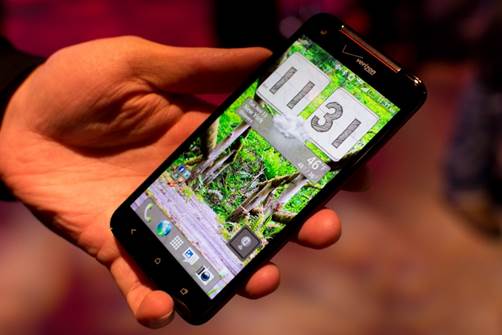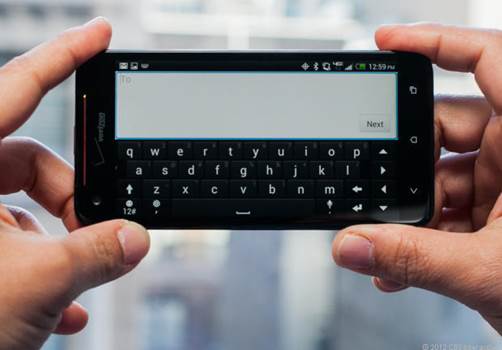Screen
And here it is: the DNA’s jewelry. The feature
that makes it stand out from the rest of the quad-core crowd: the 5-inch
screen, 1080p (1920x1080). More particularly, this IPS screen – also known as
Super LCD3 – is the SLCD2’s evolution, which you can find on the One X. If you
remember, we announced that the device's screen is the best we've seen,
however, now the DNA easily wins that title. Admittedly, it is an increase in the
repetition of resolution: the Super LCD2 screen on the One X has packed more
pixels than the human eyes can see, thus pushing up to more than 100ppi density
only makes the DNA’s screen sharper and sharper. How is it possible? Images
seem to float across the screen. The font proved to be more vivid than anything
we've ever seen, and 1080p video looks just impressive. Colors seem more
natural (not overly saturated), the blacks are darker whereas the whites are
not so bright as on the One X. The viewing angle is excellent, and you would
like to use this phone in direct sunlight because even at 50% brightness, you
can see everything and that does not hurt the eyes – something we can only talk
about a few devices. We would give the Super LCD3 screen every compliment there
is in the world, because it is the undisputed champion in the mobile industry.
It is undeniable that the 1080p display is the best screen we've seen so far,
but do not leave the 720p screen of your current phone only for this reason.
Certainly it is an improvement to repeat, and it's so cute at first sight, but
it is more important than any increase in any previous resolution. In short:
it's hard to come back to the qHD screen after using 720p for a long time, but
we do not have that same caution when returning to the One X+’s screen after
using the DNA’s.

The
viewing angle is excellent.
Software
As expected, the Droid DNA welcomed a new
set of user interface of HTC Sense 4 +, which runs on Android 4.1.1 Jelly Bean.
With the exception of the changes caused by the network, basically the UI here
is the same UI we evaluated on the One X + a few weeks ago, so please read the
assessment of us for a full analysis. We referred to special terms from the
network, which is not a surprise to anyone who has used a smartphone in the
U.S. market. Verizon has stuck with the precedent and totally destroyed the DNA
with a lot of pre-loaded applications. Fortunately, almost all of them can be
disabled and each application can be hidden from sight, thanks to a certain
function in the Sense application menu. We can live with this option,
especially since there seems to have little effect on performance, but there is
one change to the firmware that should not have happened: recent apps button /
multitasking cannot be changed or turned on/off to enable the menu key. This is
one feature you can find on the One X and X +, so it makes us believe this is
what Verizon chose to remove from the final product. Basically doing this lets
the menu button take an unusual amount of space on the screen of other third-party
applications.
The keyboard is a little different – and a
little better. The bigger screen allows slightly larger keys and symbols /
numbers switch to the left instead of right, but we are disappointed with the
slow response we had with the "trace" function like Swype on the
keyboard on the HTC keyboard. Any time any one of us finished typing a word, we
found ourselves waiting 1 or 2 seconds for the phone’s prediction to appear on
the phone's screen.

The
keyboard is a little different – and a little better.
Camera
Let's start the discussion about the DNA’s
camera by informing that we set expectations at the same level as the One X and
X +, because it has a very similar camera module. Inside the red ring on the
back is 8MP camera with wide angle lens with the aperture of f/2.0, focal
length of 3.63mm (28mm equivalent), BSI sensor, AF and HTC’s special ImageChip.
Turning the phone back, you will face the front 2.1MP camera with BSI sensor
and ultra-wide-angle lens at 88 degrees.
ISO can be set manually to a maximum of
800, but we found that number jumped to 1400 when shooting in low-light or
automatic modes. You can also adjust the white balance manually, but
unfortunately you will want to do it more often on the DNA as the auto white
balance is a bit too warm. You can also choose to use HDR, macro mode or low-light
mode and you can also adjust the exposure/contrast settings. Because the DNA
does not offer the ability to lock exposure, the adjustment will be needed more
often. When you're using the front camera, you can tap the viewfinder to start the
3-second timing to have the perfect Facebook profile picture.
Regarding performance, the camera is very
fast, even faster than the One X and X +. Photos are also sharper and have more
detailed, although as we mentioned previously, we are disappointed because the
auto white balance is quite too warm. (This is the fear of the software
addressed in future updates). But when the white balance is adjusted properly,
we have natural colors and generally good image quality. Photos in low light
are pretty good, but not so good as what we want to see from HTC, at least, bright
enough LED flash.
In other words, you will not buy this phone
for the ability to take pictures, but it also will not break the agreement.
It's not faster than the X or X +, but of course it is in the same class.
On the other hand, the front camera is
improved over the One series. The wide-angle lens creates a big difference,
especially in video chat, which is where it has value – easy to put on the
views of many more, very convenient for the group of friends and family. The
pictures, which have received an increase in resolution to 2.1MP (1920x1088)
and have more details than anything we have seen in the first HTC Android
devices at this time.

We
do not see any major improvement in the performance of the DNA on video
recording.
We do not see any major improvement in the
performance of the DNA on video recording with the rear camera, because it
shows almost the same as the One X and X+ can do. It is recorded in MPEG-4
format with the bit rate of 10Mbps and frame rate of 30fps. It is also capable
of slow-motion, which can be quite useful when filming something with more
actions, but you may also experience adverse resolution. The front camera is
great for video, so that we can record 1080p videos. We are quite surprised
about how smooth the results are; we do not have much lagging when shooting
moving objects.
|
HTC Droid
DNA
·
Price: $200 on contract
·
Dimensions: 5.55x2.78x0.38 inches
(141x70.5x9.73mm)
·
Weight: 4.86 ounces (138g)
·
Screen size: 5 inches
·
Screen resolution 1920x1080 pixels (440ppi)
·
Screen type: Super LCD3
·
Battery: 2020mAh
·
Storage: 16GB
·
External microSD slot: no
·
Rear camera: 8MP, 28mm wide-angle lens, f/2.0,
AF, BSI, ImageChip
·
Front camera: 2.1MP, f/2.0 wide-angle lens,
BSI
·
Video recording: front camera, 1080p / rear
camera, 1080p
·
NFC: yes
·
Radio: LTE, CDMA, 4-band GSM / EDGE, 4-band
UMTS / HSPA +
·
Bluetooth: version 4.0 with aptX
·
SoC: Qualcomm Snapdragon S4 Pro APQ8064
·
CPU: Quad core 1.5GHz
·
GPU: Adreno 320
·
RAM: 2GB
·
MHL: Yes, the HTC Media Link HD support also
included
·
WiFi: 802.11a/b/g/n dual-band
·
OS: Android 4.1.1 Jelly Bean; Sense UI 4 +
|